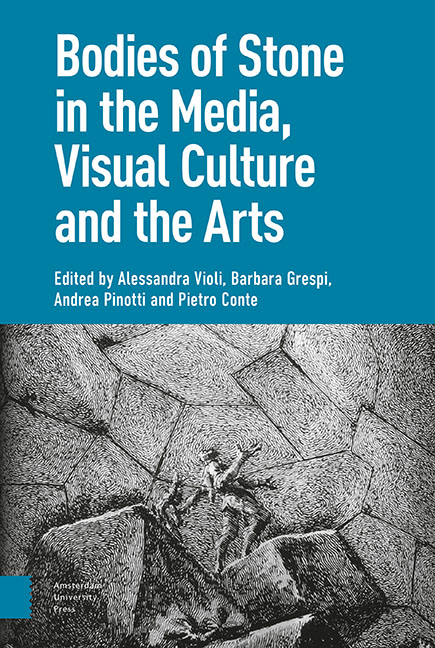Book contents
- Frontmatter
- Contents
- Introduction: Learning from Stone
- I Statue: The Imaginary of Uncertain Petrification
- 1 Theatre and Memory: The Body-as-Statue in Early Modern Culture
- 2 Translated Bodies: A ‘Cartographic’ Approach
- 3 Pantomime in Stone: Performance of the Pose and Animal Camouflage
- 4 Animated Statues and Petrified Bodies: A Journey Inside Fantasy Cinema
- 5 The Ephemeral Cathedral: Bodies of Stone and Configurations of Film
- II Matter: Size, Hardness, Duration
- 1 Bodies That Matter: Miniaturisation and the Origin(s) of ‘Art’
- 2 Brancusi’s ‘Sculpture for the Blind’
- 3 Cinema, Phenomenology and Hyperrealism
- 4 Ephemeral Bodies: The ‘Candles’ of Urs Fischer
- 5 The Celluloid and the Death Mask: Bazin’s and Eisenstein’s Image Anthropology
- III Corpse: Fossils, Auto-Icons, Revenants
- 1 Funeral Eulogy: Post-Mortem Figures and Redeemed Bodies, in Images
- 2 On Jack Torrance As a Fossil Form
- 3 Technical Images and the Transformation of Matter in Eighteenth-Century Tuscany
- 4 Glass, Mixed Media, Stone: The Bodily Stuffs of Suspended Animation
- 5 Bodies’ Strange Stories: Les Revenants and The Leftovers
- IV Monument: Embodying and Grafting
- 1 The Impassibly Fleshly, the Statue of the Impossible
- 2 Frozen into Allegory: Cleopatra’s Cultural Survival
- 3 The Orphan Image
- 4 The Well-Tempered Memorial: Abstraction, Anthropomorphism, Embodiment
- 5 Monuments of the Heart: Living Tombs and Organic Memories in Contemporary Culture
- Index
I - Statue: The Imaginary of Uncertain Petrification
Published online by Cambridge University Press: 20 November 2020
- Frontmatter
- Contents
- Introduction: Learning from Stone
- I Statue: The Imaginary of Uncertain Petrification
- 1 Theatre and Memory: The Body-as-Statue in Early Modern Culture
- 2 Translated Bodies: A ‘Cartographic’ Approach
- 3 Pantomime in Stone: Performance of the Pose and Animal Camouflage
- 4 Animated Statues and Petrified Bodies: A Journey Inside Fantasy Cinema
- 5 The Ephemeral Cathedral: Bodies of Stone and Configurations of Film
- II Matter: Size, Hardness, Duration
- 1 Bodies That Matter: Miniaturisation and the Origin(s) of ‘Art’
- 2 Brancusi’s ‘Sculpture for the Blind’
- 3 Cinema, Phenomenology and Hyperrealism
- 4 Ephemeral Bodies: The ‘Candles’ of Urs Fischer
- 5 The Celluloid and the Death Mask: Bazin’s and Eisenstein’s Image Anthropology
- III Corpse: Fossils, Auto-Icons, Revenants
- 1 Funeral Eulogy: Post-Mortem Figures and Redeemed Bodies, in Images
- 2 On Jack Torrance As a Fossil Form
- 3 Technical Images and the Transformation of Matter in Eighteenth-Century Tuscany
- 4 Glass, Mixed Media, Stone: The Bodily Stuffs of Suspended Animation
- 5 Bodies’ Strange Stories: Les Revenants and The Leftovers
- IV Monument: Embodying and Grafting
- 1 The Impassibly Fleshly, the Statue of the Impossible
- 2 Frozen into Allegory: Cleopatra’s Cultural Survival
- 3 The Orphan Image
- 4 The Well-Tempered Memorial: Abstraction, Anthropomorphism, Embodiment
- 5 Monuments of the Heart: Living Tombs and Organic Memories in Contemporary Culture
- Index
Summary
The imaginary of the body suspended between animate and inanimate finds its roots in the ancient myths of petrification, which have been thoroughly revised since the dawn of modernity. The irreversibility of the classical metamorphoses, from organic to inorganic or vice versa, has been put in question within a broad and eclectic body of literary, artistic and cinematographic work that ranges from Shakespeare, Victor Hugo and Antonia Byatt, taking in also Charlie Chaplin and Italian horror director Riccardo Freda. Though this section does not claim to give a chronological account of how this new mythology developed tropes of uncertain, reversible, incomplete, hybrid and repeated transformations, it offers samples of some key stages in this reconfiguration. The following essays turn on the figure of the statue as an inevitable starting point for the itinerary mapped out in the volume as a whole. For the statue condenses the suspensions of time, of movement and of affect that have always conjured the idea of a body that is degenerate, rigid and imprisoned, while at the same time it unsettles and seduces, encouraging the uncertainties of the gaze and threatening the fixed points of perception.
The statue sheds its definitive immobility already on the Elizabethan stage, where characters often undergo various states of freezing that fix the body in long-lasting poses that are akin to petrification but that are never certain or definitive. Greta Perletti's essay reads the recurrence of actors’ bodies as para-statues as a meditation on memory and, in Shakespeare in particular, as an effort to undermine its monumental aspect and its link to medieval artes memoriæ. On the threshold of modernity, words are better vehicles of memory than statues and, conversely, it is words that create statues of flesh paralysing the bodies that recall painful events. In Shakespeare, the memory that is harmful to the body is thus translated into a state of semi-lethargy and, more in general, into a register of dysfunctions and interruptions of the confines between flesh and stone that redefine the ancient magic in terms of the pathologies—above all female—of de-animation. Silvia Romani takes off from the classical theme of female petrification to bring out the ambiguity intrinsic in the suspended state.
- Type
- Chapter
- Information
- Publisher: Amsterdam University PressPrint publication year: 2020



